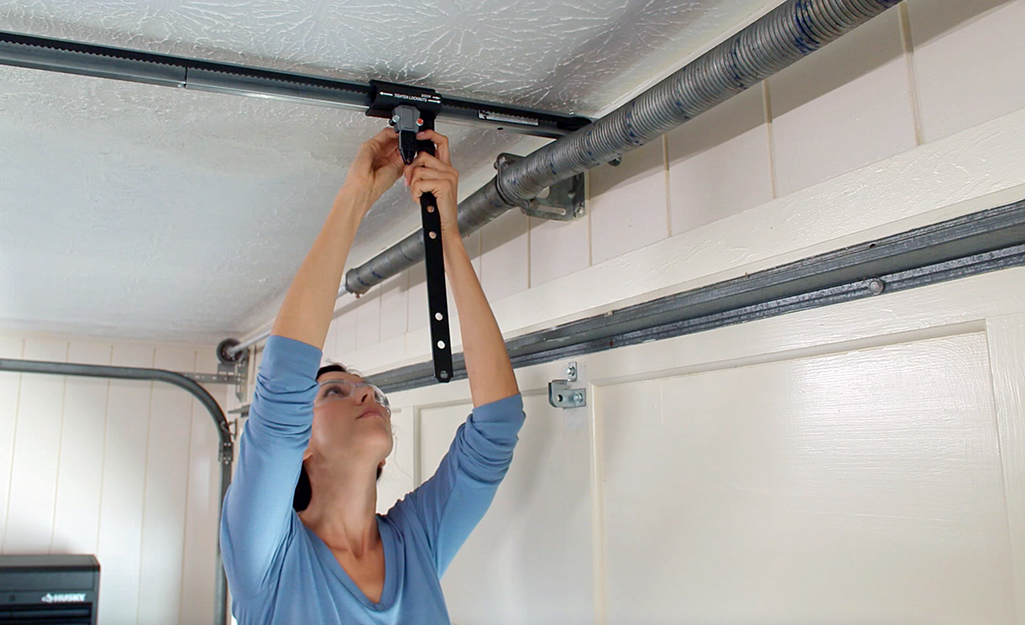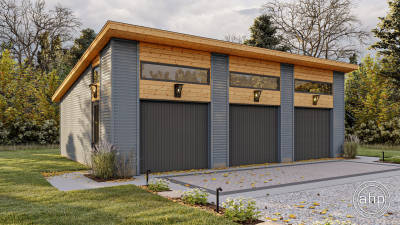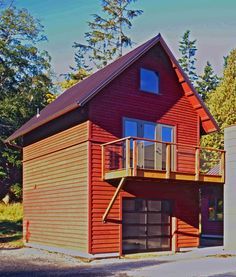
Saltbox garage is the best option for homeowners looking to expand their storage space. This garage style can keep your storage area dry in rainy or snowy areas thanks to its longer, sloping roof at the back and a shorter sloped roof at the front.
Village Street Garage: Located in Greenwich Village, this garage is the perfect place to store your car and other vehicles. Its convenient location and affordable prices make it a popular option for many New York City residents.
Home Town Garage: This garage works well for anyone, whether you are a homeowner or business owner. It's designed to be easily accessible and has plenty of space for your tools and other items.
Ivywood garage: iCreatables has many shed plans that can be used for storage in your backyard. These plans have a wood floor and double door entry. They can be easily constructed and offer a cost-effective way to store everything you need, including tools and garden supplies.

Greece Town Garage - If you are an auto enthusiast looking for body work, Greece Town Garage is the right place. They'll make sure that your car is in peak condition.
Tri City Garage: If you're a city dweller and are looking for a garage to store your car, the experts at Tri City Garage can help you out. They will make sure that your car is safe and secure, and they can get it fixed quickly.
This garage is the best place for your car, no matter if you are a professional mechanic or an amateur. It's also a great way to save money on repairs and maintenance.
This garage is easy to reach, has lots of room for cars, and is well-ventilated. Your vehicles will be able to access the garage through its 3' single and 3x7 raised panel doors.
Saltbox garages are a traditional American architectural style. It has a loft, or second story, on the front and one story on its rear. It was made to avoid Queen Anne’s taxation of two-story houses in England’s new colony.

These barns can be used as either one-story or two-story livable structures. Usually, 75% is available for use as a second-floor apartment, storage, or any other purpose.
These barns have 40 pound per square feet residential floor load capacity. They are easily customizable to meet your requirements, whether you need simple pull down or pull down stairs or a complete set of hemlock built in stairs. These barns can be fitted with a cathedral ceiling or just a loft for additional storage.
FAQ
Is it cheaper to remodel a bathroom or kitchen?
Remodeling a kitchen or bathroom is a costly undertaking. It might be more cost-effective to upgrade your home than you think, given how much you spend each month on energy bills.
Small upgrades can help you save thousands of dollars per year. A few simple changes, such as adding insulation to walls and ceilings, can reduce heating and cooling costs by up to 30 percent. Even a simple addition can increase comfort and reduce resale costs.
It is crucial to consider durability and ease of maintenance when renovating. Solid wood flooring, porcelain tile, and stainless steel appliances last longer than vinyl and laminate countertops and require less maintenance.
You may also find that replacing old fixtures with newer models can help cut utility expenses. By installing low-flow faucets, you can lower your water usage up to half a percent. Replacing inefficient lighting with compact fluorescent bulbs can cut electricity consumption by up to 75 percent.
What are the included features in a full remodel of your kitchen?
A complete kitchen remodel involves more than just replacing a sink and faucet. Cabinets, countertops, appliances and lighting fixtures are just a few of the many options available.
A complete kitchen remodel allows homeowners the opportunity to upgrade their kitchens without any major construction. This means there is no need to tear down the kitchen, making the project more manageable for both the homeowner as well as the contractor.
A kitchen renovation can include a variety of services such as plumbing, HVAC, painting, drywall installation, and electrical. Depending on the extent of the kitchen remodel, multiple contractors may be required.
Hiring professionals who are familiar with kitchen remodeling is the best way for it to go smoothly. Small issues can lead to delays when there are many moving parts involved in a kitchen remodel. DIY projects can cause delays so make sure you have a backup plan.
How do I determine if my house requires a renovation or remodel?
First, consider whether your home has been updated in recent times. If you haven't seen any updates for a few years, it may be time to consider a renovation. A remodel may be a better option if your house looks like new.
Your home's condition is also important. A renovation may be necessary if your home has holes in its drywall, cracked wallpaper, or missing tiles. It's possible to remodel your home if it looks good.
A second factor to consider is your home's general condition. Is your house structurally sound? Do the rooms look nice? Are the floors spotless? These are vital questions to ask when you decide which type of renovation should be done.
How much does it cost to gut and renovate a kitchen completely?
You might wonder how much it would be to remodel your home if you have been considering the idea.
The average cost of a kitchen remodel between $10,000 and $15,000. There are ways to save on your kitchen remodel while still improving the space's look and feel.
Preparing ahead can help you cut down on your costs. You can do this by choosing a design style that suits you and your budget.
Hiring an experienced contractor is another way of cutting costs. A skilled tradesman will know exactly what to do with each stage of the construction process. This means that he or she won’t waste time trying out different methods.
You should consider whether to replace or keep existing appliances. A kitchen remodel can add thousands to the cost by replacing appliances.
You might also consider buying used appliances over new ones. You will save money by purchasing used appliances.
It is possible to save money when you shop around for materials, fixtures, and other items. Many stores offer discounts on special occasions such as Cyber Monday and Black Friday.
What is the cost of tile for a shower?
If you're going to do it yourself, you might as well go big. A full bathroom remodels an investment. It is worth the investment in high-quality fixtures and materials, especially when you consider the long-term benefits of having a beautiful space that will last for many years.
The right tiles will make a big difference in the way your room feels and looks. Here's how to choose the right tiles for your home, regardless of whether it's a small renovation or major project.
The first step is to decide what type of flooring you would like to install. The most common options are ceramics, stone, porcelain, and natural timber. Select a style, such as classic subway tiles or geometric patterns. The last step is to choose a color scheme.
For large bathroom remodels, you will likely want the tiles to match the rest of your room. For example, you may opt for white subway tile in the kitchen and bath area while choosing darker colors in other rooms.
Next, determine the size of the project. Is it time to update a small powder room? Or would you prefer to add an extra bedroom in your master suite with a walkin-in closet?
After you have established the project's scope, it is time to visit local stores and view samples. You can then get a feel of the product and how it is installed.
Shop online for amazing deals on ceramic and porcelain tiles Many retailers offer free shipping and discounts on bulk purchases.
What are the top expenses associated with remodeling a Kitchen?
There are several major costs involved in a kitchen remodel. These include demolition, design fees, permits, materials, contractors, etc. Although these costs may seem relatively small, if you take them all together, they can quickly add up. They quickly grow when added together.
The most expensive cost is probably the demolition. This includes removing any cabinets, appliances, countertops or flooring. You will then need to remove the insulation and drywall. You must then replace these items with new ones.
Next, you must hire an architect to draw out plans for the space. You will need permits to ensure your project meets the building codes. After that, you have to find someone to do the actual construction.
Once the job is complete, you will need to pay the contractor. You could spend anywhere from $20,000 to $50,000, depending on how large the job is. This is why it's important to get estimates form multiple contractors before hiring one.
If you plan, you can often avoid some of these costs. You may be able get better material deals or to skip some of the work. You will be able save time and money if you understand what needs to done.
Many people install their cabinets by themselves. Because they don't have professional installation fees, this is a way to save money. However, this can lead to them spending more to learn how to place cabinets. A professional can usually complete a job in half of the time that it would take you.
Another way to save is to purchase unfinished materials. You must wait until the cabinets are fully assembled before purchasing pre-finished material. Unfinished materials can be used immediately by you if purchased. If things don't work out as planned, you can always modify your mind later.
Sometimes it is not worth the hassle. It is important to plan your home improvement projects in order to save money.
Statistics
- $320,976Additional home value: $152,996Return on investment: 48%Mid-range average cost: $156,741Additional home value: $85,672Return on investment: (rocketmortgage.com)
- Following the effects of COVID-19, homeowners spent 48% less on their renovation costs than before the pandemic 1 2 (rocketmortgage.com)
- 55%Universal average cost: $38,813Additional home value: $22,475Return on investment: 58%Mid-range average cost: $24,424Additional home value: $14,671Return on investment: (rocketmortgage.com)
- 57%Low-end average cost: $26,214Additional home value: $18,927Return on investment: (rocketmortgage.com)
- bathroom5%Siding3 – 5%Windows3 – 4%Patio or backyard2 – (rocketmortgage.com)
External Links
How To
How to Install Porch Flooring
Although porch flooring installation is simple, it requires some planning and preparation. Laying a concrete slab is the best way to install porch flooring. But, if you don’t have the concrete slab available, you could lay a plywood board deck. This allows you to install your porch flooring without spending a lot of money on a concrete slab.
The first step when installing porch flooring is to secure the subfloor (the plywood). You will need to measure the porch's width and cut two strips of plywood equal to it. These strips should be placed along both sides of the porch. Next, nail them down and attach them to your walls.
Once you have secured the subfloor, you will need to prepare the space where you want to install the porch flooring. This usually involves cutting the floorboards' top layer to the required size. You must then finish your porch flooring. A common finish is a polyurethane. It is possible to stain porch flooring. Staining is more straightforward than applying a coat of clear paint. After applying the final coat, you just need to sand down the stained areas.
Once you have completed these tasks, you can finally install the porch flooring. First, measure and mark the location of your porch flooring. Next, cut the porch flooring to size. Finally, put the porch flooring in its place and nail it.
If you want to increase the stability of your porch flooring's floor, you can install porch stairs. Porch stairways are typically made of hardwood. Some people prefer to add their porch stairs before installing their porch flooring.
Once your porch flooring is installed, it is time for the final touches. You first have to take out the old porch flooring and put in a new one. Next, clean up all debris. Remember to take care of the dust and dirt around your home.